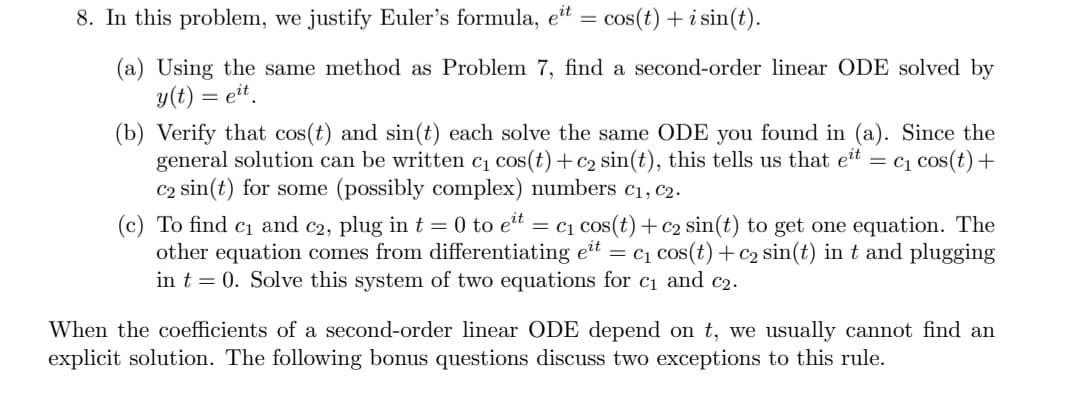8. In this problem, we justify Euler's formula, et = cos(t) + i sin(t). (a) Using the same method as Problem 7, find a second-order linear ODE solved by y(t) = eit. (b) Verify that cos(t) and sin(t) each solve the same ODE you found in (a). Since the general solution can be written c₁ cos(t)+c₂ sin(t), this tells us that eit = C₁ cos(t) + C2 sin(t) for some (possibly complex) numbers C₁, C2. (c) To find c₁ and c2, plug in t = 0 to eit = c₁ cos(t) + c2 sin(t) to get one equation. The other equation comes from differentiating eit =c₁ cos(t) + c₂ sin(t) in t and plugging in t = 0. Solve this system of two equations for c₁ and c₂. When the coefficients of a second-order linear ODE depend on t, we usually cannot find an explicit solution. The following bonus questions discuss two exceptions to this rule.
8. In this problem, we justify Euler's formula, et = cos(t) + i sin(t). (a) Using the same method as Problem 7, find a second-order linear ODE solved by y(t) = eit. (b) Verify that cos(t) and sin(t) each solve the same ODE you found in (a). Since the general solution can be written c₁ cos(t)+c₂ sin(t), this tells us that eit = C₁ cos(t) + C2 sin(t) for some (possibly complex) numbers C₁, C2. (c) To find c₁ and c2, plug in t = 0 to eit = c₁ cos(t) + c2 sin(t) to get one equation. The other equation comes from differentiating eit =c₁ cos(t) + c₂ sin(t) in t and plugging in t = 0. Solve this system of two equations for c₁ and c₂. When the coefficients of a second-order linear ODE depend on t, we usually cannot find an explicit solution. The following bonus questions discuss two exceptions to this rule.
Advanced Engineering Mathematics
10th Edition
ISBN:9780470458365
Author:Erwin Kreyszig
Publisher:Erwin Kreyszig
Chapter2: Second-order Linear Odes
Section: Chapter Questions
Problem 1RQ
Related questions
Question

Transcribed Image Text:8. In this problem, we justify Euler's formula, eit
=
cos(t) + i sin(t).
(a) Using the same method as Problem 7, find a second-order linear ODE solved by
y(t) = eit.
(b) Verify that cos(t) and sin(t) each solve the same ODE you found in (a). Since the
general solution can be written c₁ cos(t)+c₂ sin(t), this tells us that eit = C₁ cos(t) +
C2 sin(t) for some (possibly complex) numbers C₁, C2.
(c) To find c₁ and c2, plug in t = 0 to eit = c₁ cos(t) + c2 sin(t) to get one equation. The
other equation comes from differentiating eit = C₁ cos(t) + c₂ sin(t) in t and plugging
in t = 0. Solve this system of two equations for c₁ and c₂.
When the coefficients of a second-order linear ODE depend on t, we usually cannot find an
explicit solution. The following bonus questions discuss two exceptions to this rule.
Expert Solution
This question has been solved!
Explore an expertly crafted, step-by-step solution for a thorough understanding of key concepts.
This is a popular solution!
Trending now
This is a popular solution!
Step by step
Solved in 3 steps with 2 images

Recommended textbooks for you

Advanced Engineering Mathematics
Advanced Math
ISBN:
9780470458365
Author:
Erwin Kreyszig
Publisher:
Wiley, John & Sons, Incorporated

Numerical Methods for Engineers
Advanced Math
ISBN:
9780073397924
Author:
Steven C. Chapra Dr., Raymond P. Canale
Publisher:
McGraw-Hill Education

Introductory Mathematics for Engineering Applicat…
Advanced Math
ISBN:
9781118141809
Author:
Nathan Klingbeil
Publisher:
WILEY

Advanced Engineering Mathematics
Advanced Math
ISBN:
9780470458365
Author:
Erwin Kreyszig
Publisher:
Wiley, John & Sons, Incorporated

Numerical Methods for Engineers
Advanced Math
ISBN:
9780073397924
Author:
Steven C. Chapra Dr., Raymond P. Canale
Publisher:
McGraw-Hill Education

Introductory Mathematics for Engineering Applicat…
Advanced Math
ISBN:
9781118141809
Author:
Nathan Klingbeil
Publisher:
WILEY

Mathematics For Machine Technology
Advanced Math
ISBN:
9781337798310
Author:
Peterson, John.
Publisher:
Cengage Learning,

